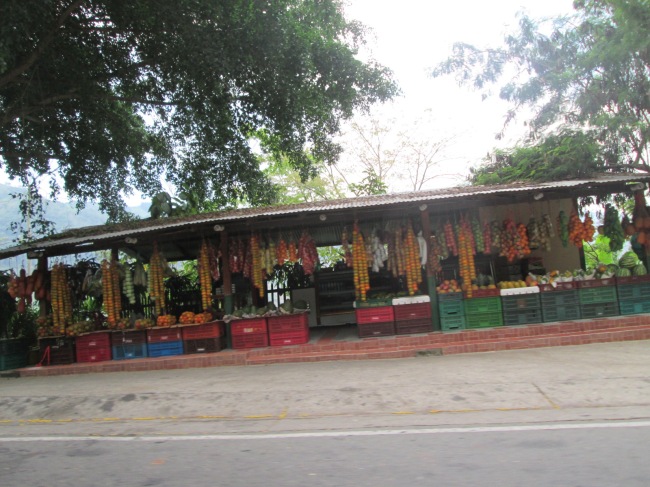Eat Healthy + Eat Local = A Colombian Localvore.
 The Locavore, or Localvore, movements emphasize eating locally grown and produced food because it benefits the local economy, personal health and is globally and environmentally responsible. While the “Localvore Movement” is picking up steam in the U.S., it has been the way of life in Colombia for generations.
The Locavore, or Localvore, movements emphasize eating locally grown and produced food because it benefits the local economy, personal health and is globally and environmentally responsible. While the “Localvore Movement” is picking up steam in the U.S., it has been the way of life in Colombia for generations.
Colombia finds itself at a critical intersection of development. Modern cities, stocked supermarkets, imported specialty items, and glitzy malls packed with international chain stores compete with the local traditional markets unique to this country.
Comida Typica (typical food) signs line highways and decorate storefronts in towns and cities. These restaurants, famous for offering set menu items, are ubiquitous and people flock to them. A selection of grilled meats accompanied by soup, fresh juice, salad, avocado, rice and cooked banana is standard fare in many parts of Colombia. This feast, more than I can eat, is a traditional lunch and costs three to four US dollars. While Colombian food is not internationally recognized, it has mastered what the western world is trying to reclaim.
Though this food is prepared in bulk for the influx of customers and served quickly, it is not Fast Food. Ingredients are fresh, always supplied by local farms. Meals are prepared by hand and taste delicious because they are fresh. Because flavor fades over time and food in the U.S. is consumed so far from its source we don’t know what we are missing. You will notice the difference in taste immediately.
Local cuisines developed out of specific climates that vary wildly. On the Atlantic coast, coconut is a common ingredient in everything from rice and fish to juice and candies. Fresh grilled trout is standard fare in the river regions, while in the colder mountains the specialty is Ajiaco, a hearty potato soup served with shredded chicken, capers, and cream. No meal is complete without a serving of rice and avocado.
In Colombia, papayas hang awkwardly from trees, falling mangos are a hazard and pineapple plantations cover La Mesa, a hot and dry region in the central mountains. While on a food safari, I found dozens of fruits beyond the kiwis, banana and strawberries familiar in the USA; numerous varieties, considered exotic elsewhere, are common place here: pitahaya, tomate de arbol, lulo, maracuyá, uchuvas, granadilla, and guanábana to name a few. Lately I enjoy “fruit adventures” where I sample new juice or buy some outlandish species at the local fruiteria (fruit market.) Many things look alien or prehistoric, but their unusual flavors always reward my bravery.
After living in Santander, Colombia for five years, I discovered a new flavor in the most familiar of places. I hike the same mountain trail weekly and am familiar with the strange shape of the Cacao pods hanging from trees reminiscent of ‘Invasion of the Body Snatchers,’ beautiful yellow and crimson as they ripen. Although the seeds are destined to be dried, ground and turned into chocolate, it never occurred to me to eat one of these mysterious pods. However, it turns out that before chocolate becomes chocolate, it is something even better! Recently a friend plucked an orange cocoa pod and broke it open, revealing a white slippery flesh so satisfyingly tangy that I can now only think of chocolate as a runner-up.
In the United States the Localvore Movement and its cousin, the farm-to-plate movement, aspire to what is still being done here without fanfare. Healthful, local, affordable food prepared by real people fuels a nation.The abundance of delicious and cheap, fresh food makes Colombia an eater’s paradise.
Sierra Melcher © 2/2014
